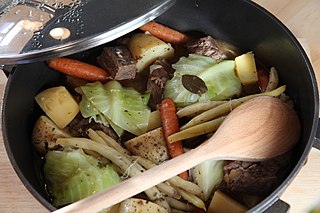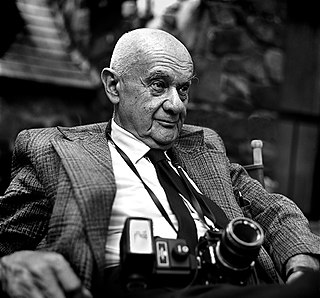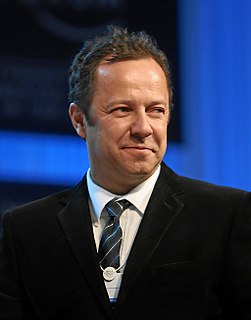Related Research Articles

A pancake is a flat cake, often thin and round, prepared from a starch-based batter that may contain eggs, milk and butter and cooked on a hot surface such as a griddle or frying pan, often frying with oil or butter. Archaeological evidence suggests that pancakes were probably the earliest and most widespread cereal food eaten in prehistoric societies.
Robert Frank was a Swiss photographer and documentary filmmaker, who became an American binational. His most notable work, the 1958 book titled The Americans, earned Frank comparisons to a modern-day de Tocqueville for his fresh and nuanced outsider's view of American society. Critic Sean O'Hagan, writing in The Guardian in 2014, said The Americans "changed the nature of photography, what it could say and how it could say it. [ ... ] it remains perhaps the most influential photography book of the 20th century." Frank later expanded into film and video and experimented with manipulating photographs and photomontage.

Québec's cuisine is a national cuisine in the Canadian province of Quebec descended from 16th-century French cuisine. Québec's cuisine began to develop in New France from the labour-intensive nature of colonial life, the seasonality of ingredients and the need to conserve resources. Québec's cuisine has been influenced by the province's history of fur trading and hunting, as well as Québec's winters, soil fertility, teachings from First Nations, British cuisine, American cuisine, historical trade relations and some immigrant cuisines.
William Eggleston is an American photographer. He is widely credited with increasing recognition for color photography as a legitimate artistic medium. Eggleston's books include William Eggleston's Guide (1976) and The Democratic Forest (1989).

Roger Fenton was a British photographer, noted as one of the first war photographers.
Street photography, also sometimes called candid photography, is photography conducted for art or enquiry that features unmediated chance encounters and random incidents within public places. Although there is a difference between street and candid photography, it is usually subtle with most street photography being candid in nature and some candid photography being classifiable as street photography. Street photography does not necessitate the presence of a street or even the urban environment. Though people usually feature directly, street photography might be absent of people and can be of an object or environment where the image projects a decidedly human character in facsimile or aesthetic.

Elliott Erwitt is a French-born American advertising and documentary photographer known for his black and white candid photos of ironic and absurd situations within everyday settings. He has been a member of Magnum Photos since 1953.

Jean-Baptiste Gustave Le Gray was a French painter, draughtsman, sculptor, print-maker, and photographer. He has been called "the most important French photographer of the nineteenth century" because of his technical innovations, his instruction of other noted photographers, and "the extraordinary imagination he brought to picture making." He was an important contributor to the development of the wax paper negative.

Garry Winogrand was an American street photographer, known for his portrayal of U.S. life and its social issues, in the mid-20th century. Photography curator, historian, and critic John Szarkowski called Winogrand the central photographer of his generation.

Bernard Faucon is a French photographer and writer. He first established a career in art photography and has exhibited widely around the world.

Roman Vishniac was a Russian-American photographer, best known for capturing on film the culture of Jews in Central and Eastern Europe before the Holocaust. A major archive of his work was housed at the International Center of Photography until 2018, when Vishniac's daughter, Mara Vishniac Kohn, donated it to The Magnes Collection of Jewish Art and Life at the University of California, Berkeley.

Vik Muniz is a Brazilian artist and photographer. Initially a sculptor, Muniz grew interested with the photographic representations of his work, eventually focusing completely on photography. Primarily working with unconventional materials such as tomato sauce, diamonds, magazine clippings, chocolate syrup, dust, dirt, etc., Muniz creates works of art, referencing old master's paintings and celebrity portraits, among other things, and then photographs them. His work has been met with both commercial success and critical acclaim, and has been exhibited worldwide. He is currently represented by Galeria Nara Roesler based in New York and Brazil.
Max Pam is an Australian photographer.

Aron Streit, Inc. is a kosher food company founded in Manhattan, New York City, best known for its product Streit's Matzo. It is the only family-owned and operated matzo company in the United States, and distributes matzo in select international markets. It holds about 40 percent of the United States matzo market with its major competitor, New Jersey based Manischewitz.
Fredi Marcarini was a notable Italian photographer. He is well known for his dramatic portrait photographs. He died of a heart attack on 10/01/2020.
Robert McFarlane is an Australian photographer and photographic critic.
John Ranard was a social documentary photographer who won critical acclaim for his gritty, multi-layered photographs of Louisville, Kentucky's social classes, the world of boxing, Russia during the period of perestroika, AIDS in Russia and Russian prison life.
Neeta Madahar is a British artist who specialises in photography of nature, birds, and flora. She has had solo exhibitions in Canada, Barcelona, Berlin, Boston, France, London, and New York and had a book, Flora, published by Nazraeli Press. She was named as one of the UK's 50 most significant contemporary photographers in an issue of Portfolio Magazine.
The Laurence Miller Gallery is a contemporary art gallery in New York City, and has been described as "one of the longest-running American galleries devoted to photography".
PhotoForum Inc. is a non-profit New Zealand photography organisation founded 12 December 1973 in Wellington "dedicated to the promotion of photography as a means of communication and expression," and is also the title of its magazine, first published in February 1974.
References
- ↑ Fallis, Greg (October 7, 2007). "Sunday Salon - Les Krims". Utata. Archived from the original on December 17, 2009. Retrieved December 24, 2009.
- ↑ "The Deerslayers". Covering Photography. 2003. Retrieved December 24, 2009.
- ↑ Les Krims: Artwork Images, Exhibitions, Reviews Archived 2012-07-17 at archive.today
- ↑ Johnson, Ken (April 16, 2004). "ART IN REVIEW - ART IN REVIEW; Les Krims -- 'Fact or Fiction'". The New York Times . Retrieved December 24, 2009.
- ↑ "Les Krims - Exhibitions" . Retrieved December 24, 2009.
- ↑ "Vice Magazine: PARIS - LES KRIMS SHOW". February 14, 2007. Archived from the original on October 2, 2008. Retrieved December 24, 2009.